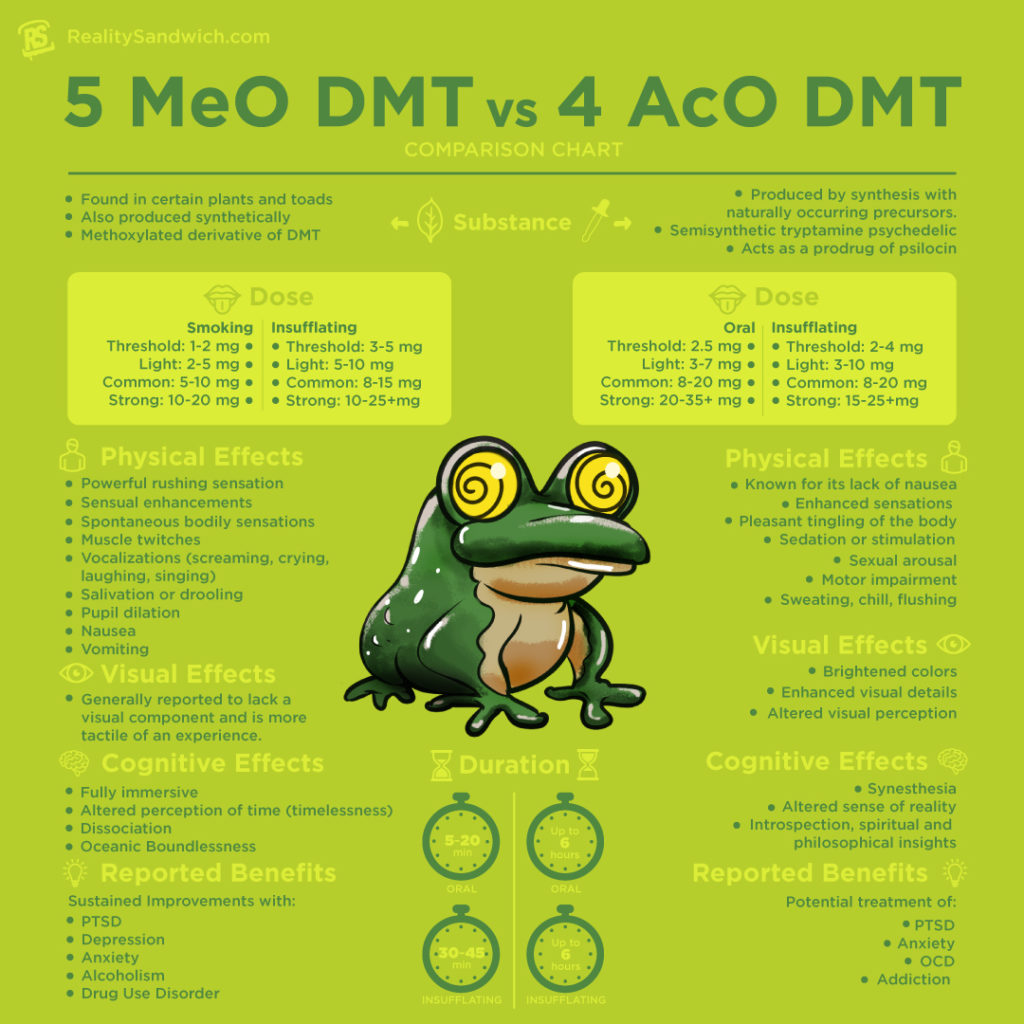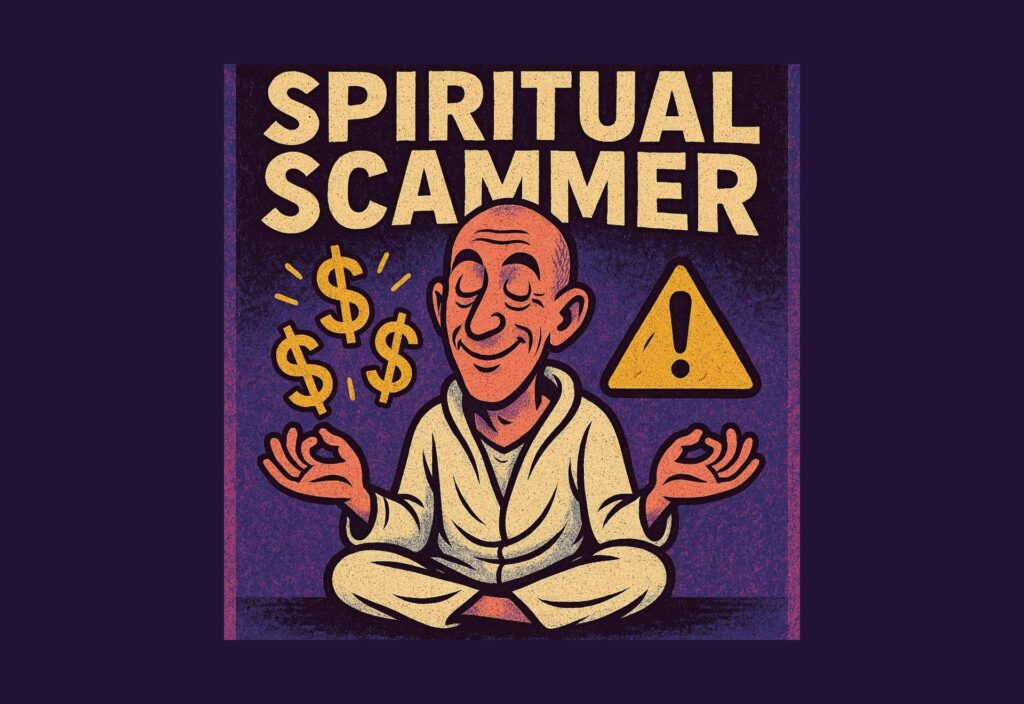4-AcO-DMT (4-Acetoxy-N,N-dimethyltryptamine) is a semisynthetic tryptamine psychedelic that acts as a prodrug of psilocin, one of the main psychoactive compounds found in magic mushrooms. Since the compound metabolizes into psilocin in the body, similar to psilocybin, its effects closely resemble those of magic mushrooms. The Swiss chemist Albert Hofmann, as well as Franz Troxler at Sandoz Laboratories in Switzerland, first synthesized 4-AcO-DMT in 1963 . Its recreational use peaked in the 2010s following its arrival to the online research chemical market.
What is 4-AcO-DMT?
4-AcO-DMT is a semisynthetic substance, meaning it is produced by synthesis with naturally occurring precursors. Other names for 4-AcO-DMT include psilacetin, 4-Acetoxy-DMT, and O-Acetylpsilocin.
4-AcO-DMT is encountered as an off-white or brown crystalline powder, either as its fumarate or hydrochloride salt. By far, the most common method of ingestion is oral, either by mixing the powder in solution or by taking tablets, capsules, or gel tabs. It can also be taken intranasally by insufflation, which produces a slightly shorter trip that comes on more rapidly.
The most common method of production is through acetylation of psilocin under alkaline or acidic conditions. Acetylation is a reaction that adds an acetyl functional group to a chemical compound. It produces effects similar or even identical to psilocybin’s, since they are both prodrugs of psilocin.
However, some users speculate that 4-AcO-DMT may produce its own psychoactive effects as well. Indeed, users that have injected or smoked it report near-immediate psychoactive effects. Both of these routes of administration bypass first-pass metabolism by the liver.
Pharmacology and Chemistry
The complete mechanism of action of 4-AcO-DMT is not completely understood at this time. However, scientists currently believe it acts as a prodrug of psilocin in the same way that psilocybin does. Dr. David Nichols even suggests it could be used as an alternative to psilocybin in pharmacological studies, given that it is a less challenging ester to synthesize.
Some users believe it has its own psychoactive properties as well. They report slightly differing effects between 4-AcO-DMT and psilocybin. Similar to other psychedelics, 4-AcO-DMT is an agonist of serotonin 5-HT2A receptors.
4-AcO-DMT’s chemical structure is similar to that of DMT with an attached acetoxy group on its indole ring. Similar to psilocybin (4-PO-DMT), 4-AcO-DMT is an ester of psilocin. While psilocybin is the O-phosphorylated form of psilocin, 4-AcO-DMT is the O-acetylated form. In its synthesis, psilocin is acetylated under either alkaline or acidic conditions. This makes it a semisynthetic compound since the precursor, psilocin, is a natural compound. Once ingested, 4-AcO-DMT is metabolized by the liver and deacetylated to psilocin.
Common 4-AcO-DMT Dose
A common dose range for 4-AcO-DMT is 8–20 mg when orally ingested or insufflated. When insufflated, the effects come on more rapidly and don’t last as long. No matter the route of administration, aftereffects may be apparent for 12–14 hours following ingestion.
| Threshold | Light | Common | Strong | |
| Oral | 2.5 mg | 3–7 mg | 8–20 mg | 20–35+ mg |
| Insufflation | 2-4 mg | 3–10 mg | 8–20 mg | 15–25+ mg |
Physical Effects
One of the aspects of 4-AcO-DMT that draws so many users to it is its general lack of nausea in comparison to psilocybin mushrooms. While some users may still experience nausea after consuming 4-AcO-DMT, it is far less likely than with psilocybin mushrooms. Some users also report less of a body load than with psilocybin mushrooms. A body load is the feeling that your body is becoming heavier or more full and is generally uncomfortable. Other physical effects include:
- Enhanced sensations
- Pleasant tingling of the body
- Sedation or stimulation
- Sexual arousal
- Dilated pupils
- Motor impairment
- Sweating
- Chills
- Flushing
- Increased heart rate
- Muscle fatigue
- Nausea
Cognitive Effects
The cognitive effects of 4-AcO-DMT are nearly identical to those of psilocybin mushrooms due to the way both compounds act as a prodrug of psilocin. With that said, many users report the 4-AcO-DMT trip has a warmer or more euphoric quality compared to psilocybin-containing mushrooms. These effects will vary based on dosage, the individual, and set and setting, but can include:
- Brightened colors
- Enhanced and altered visual perception
- Introspection, spiritual and philosophical insights
- Contact with autonomous entities
- Inner peace
- Induction of a dream-like state
- Euphoria
- Enhanced empathy
- Altered sense of reality
- Closed and open eye visuals
- Auditory hallucinations
- Altered thought patterns
- Distorted sense of time
- Loss of ego
- Synesthesia
- Anxiety and fear
- Paranoia
- Sleeplessness
Top Reported Benefits
Reported benefits of consuming 4-AcO-DMT are similar to those of most other psychedelics, particularly psilocybin mushrooms. 4-AcO-DMT may hold therapeutic potential for the treatment of depression, PTSD, anxiety, OCD, and addiction. Microdosing 4-AcO-DMT (1–2.5 mg regimented doses) may enhance sociability, improve mood, and increase creativity and focus.
One user reports that several 4-AcO-DMT trips and subsequent integration provided profound relief to his depression and OCD symptoms. His trips allowed him to process and heal childhood trauma, examine self-limiting beliefs, accept himself fully, and vent deeply repressed emotions.
Another user reports 4-AcO-DMT helped with quitting cigarettes, and understanding the beneficial aspects of alone time after consistently being in long-term relationships.
With a 20 mg oral dose, one user reports a healing experience that allowed him to further accept and appreciate his own individuality. He also realized that he had too many possessions and was too involved with negative news. This led him to live a happier, more fulfilling life after the trip.
After an extremely high dose, one user also reports he felt the heavy trip helped him overcome a wide range of substance addictions.
Common Risks or Side Effects
With the limited history of use and research available on 4-AcO-DMT, a comprehensive set of risks cannot be determined at this time. Being a relatively recent research chemical, the long-term safety and toxicity of 4-AcO-DMT haven’t been studied in a clinical context.
Due to its chemical similarity to psilocybin and psilocin, however, it’s assumed to have a similar safety profile. Like psilocybin, 4-AcO-DMT is considered to be non-addictive and with low abuse potential. High doses (above 25 mg) have not been linked to fatalities. However, these doses have caused severe adverse effects such as blackouts, seizures, hypertension, and vomiting.
Taking 4-AcO-DMT with lithium, tramadol, and stimulants such as amphetamines and cocaine may increase the chance of seizures or psychosis, so these combinations are strongly discouraged. In addition, 4-AcO-DMT’s effects may be strongly potentiated by MAOIs (monoamine oxidase inhibitors), MDMA, and cannabis. These combinations may increase the chance of negative psychological symptoms such as paranoia, panic attacks, anxiety, and psychosis.
The largest risk of taking any psychedelics includes the potential to develop HPPD, PTSD, or psychosis. HPPD, or hallucinogen persisting perception disorder, involves a user experiencing hallucinations well after a trip has ended. These hallucinations vary from minor to severe. Some individuals suffering from this disorder experience light visual snow while others experience full-blown hallucinations. A particularly difficult or negative trip can cause HPPD or PTSD. Psychosis particularly affects individuals with a history of schizophrenia or psychotic breaks. Most users never experience any of these disorders, but they can occur.
4-AcO-DMT Legality
In the United States, the Controlled Substances Act does not list 4-AcO-DMT as a controlled substance. However, its use, sale, and possession can be prosecuted as for a Schedule 1 substance under the Federal Analog Act if the purpose is for human consumption.
Australia lists 4-AcO-DMT as a Schedule 9 prohibited substance under the Poisons Standard as an analog of psilocin.
The United Kingdom lists it as a Class A drug under the Misuse of Drugs Act.
Italy and Sweden also list 4-AcO-DMT as a controlled substance.

4-AcO-DMT vs 5-MeO-DMT: What’s the Difference?
Despite both 5-MeO-DMT and 4-AcO-DMT being derivatives of DMT, they act in very different ways within the body and produce vastly different effects. 4-AcO-DMT likely acts as a prodrug of psilocin, making it closer in effects to psilocybin than DMT or 5-MeO-DMT.
The most common way to make 5-AcO-DMT involves the semisynthesis of psilocin through acetylation under alkaline or acidic conditions. The effects of 4-AcO-DMT last up to six hours, whereas 5-MeO-DMT’s effects only last for up to an hour.
They also differ in the way they are consumed. 5-MeO-DMT does not activate when ingested orally without an MAOI (a potentially dangerous combination) and must be either insufflated or smoked. 4-AcO-DMT can be ingested orally or insufflated, but produces toxic compounds when smoked if not in a freebase form.
FAQ
How long does it take for 4-AcO-DMT to peak?
4-AcO-DMT is metabolized by the body more quickly than mushrooms that contain psilocybin. For this reason, the trip usually comes on more rapidly and intensely than with magic mushrooms. When orally ingested, the effects typically peak in 2 to 3 hours. When insufflated, the “come up” is more rapid, and the effects peak in 1 to 3 hours.
What is 4-AcO-DMT Fumarate?
4-AcO-DMT fumarate is one of the two salt forms of 4-AcO-DMT that contains two molecules of 4-AcO-DMT bound to one molecule of fumarate. 4-AcO-DMT is most commonly synthesized as the fumarate crystalline salt. Compared to the hydrochloride salt (4-AcO-DMT HCl), 4-AcO-DMT fumarate is more stable but slightly less potent. By weight, 4-AcO-DMT HCl is approximately 7% more potent than the fumarate salt.
RS Contributing Author: Dylan Beard
Dylan Beard is a freelance science writer and editor based in the beautiful Pacific Northwest. After finishing his physics degree and dabbling in neuroscience research at UC Santa Barbara in 2017, he returned to his first love: writing. As a long-term fan of the human brain, he loves exploring the latest research on psychedelics, nootropics, psychology, consciousness, meditation, and more. When not writing, you can probably find him on hiking trails around Oregon and Washington or listening to podcasts. Feel free to follow him on Insta @dylancb88.














